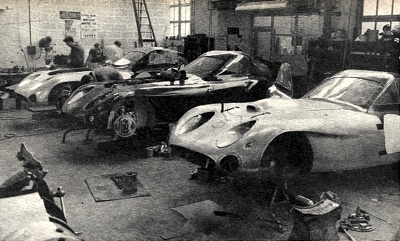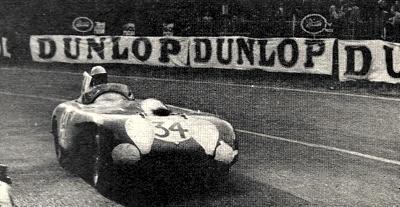Bristol 450
Reviewed by Unique Cars and Parts
Our Rating: 5
Bristol 450
The terse success story of the Bristol Car Company's three-year campaign in two litre racing was almost unknown outside the small circle of factory personnel and racing enthusiasts who witnessed it, yet it was one that produced the wildly imaginative Bristol 450s. This was due to the tight-lipped policy of the Bristol Aircraft Company's car-making branch.
The breach between making cars and aircraft was not as great as it seemed.
Saab and
Rolls-Royce were operating successfully in both fields, and racing gave Bristol a chance to show its cars were as dependable as its aircraft. Nevertheless, in the
1953 to
1955 period, interest in two litre cars was far from great. And while a three-car sweep class win was doubly impressive when it was scored twice in two successive years, as Bristol did at Le Mans with the 450s, finishing seventh eighth and ninth overall positions rarely made the headlines.
George White
The reasons behind Bristol's entrance into sports car racing were never clearly defined, but there can be little doubt that the prospect of competition success to underscore the basic quality of the Bristol line of fast sports-tourers enticed George White, son of the aircraft founder. Under White's direction, Bristol began production of cars just after World War 2.
At the London Motor Show in November,
1952, George White announced that Bristol would be represented at the
1953 Le Mans. His directive, with only eight months of working time ahead, put Vivian Selby, the firm's sales manager, in charge of the crash program. Apart from their
engines and
transmissions, the heavy and luxurious
Bristol passenger cars didn't offer a basis from which to work.
ERA 3-Type
Since time did not permit evolution of an all-chassis, an important short cut was authorised: Bristol bought from
ERA (
English Racing Automobiles), the Hodkin-designed chassis of its 3-type. This car had shown promise in the then-current two-litre Formula 2 racing category. Bristol's adaptation of the
ERA frame maintained its key features: tubular side members of massive cross section, they angled sharply upward to provide abutments for the
coil spring/ shock absorber units. While the 450's chassis heritage is evident it had some dissimilarities from the
ERA original. The main difference was that the Bristol frame used round steel tubes of 4.5 in diameter for its main members in place of the 6 in diameter aluminium tubes used by
ERA.
In addition, the frame of the 450 was about three-and-one-half pounds heavier than BRA's. Bristol used five crossties, including one a few inches from the rear
suspension riser. The rectangle it formed was criss-crossed by two small-diameter diagonals to carry the differential unit. The 450 had a very long hood and the pronounced tail fins were evidence that Bristol cars had been tested in Bristol Aircraft's wind tunnel. The body panels, supported by small-diameter tubes, were made of thin aluminium. Sprayed British racing green, the cars were pronounced ready for Le Mans.
The Bristol Rockerbox Six
The engine for the 450 racing cars was essentially a low-compression version of the aluminium-headed rockerbox six that Bristol had been supplying to Cooper,
ERA, Frazer-Nash and others for Formula 2 racers, and traced its beginnings to the pre-World War 2
BMW 328 engine. Bristol paid homage to its power source by designing the grilles of its early sedans after that of the BMW. The engine was almost lost under the Bristol's broad hood. It was flanked by side-mounted fuel tanks which contributed to the broad-shouldered stance of the 450s.
In addition, while
ERA had converted its engines to dry-sump operation, Bristol retained an oil pan. However, a 2.75 gallon tank in the left front fender was used to replenish tlie supply as it was consumed and gave rise to the fallacy that the 450's had dry sumps too. The wide stance of the Bristols was no illusion. Their width, in both coupe and roadster versions, was 65 inches, although the overall length shrank more than a foot when the open car replaced the 176 in coupe for 1955. The 450's engines were developing 142 bhp at 6000 rpm when they began racing in
1953 at Le Mans. Refinements raised it to 155 at 6000.

Bodywork for the open 450s was based on this cardboard mockup used for wind-tunnel experiments.

Work on the 2nd Series Coupes being done at the Bristol factory.

An open Bristol 450 at the 1955 Le Mans. It came in 8th position.
|
The Bristol 450s At Le Mans
The first edition of the Bristol 450 (two appeared at
1953 Le Mans 24-hour race in June) showed a curious mixture of inventiveness and styling abandon. This was probably a result of the great pressure put on the firm's racing crew to produce a great car at first try. The front of the car was marred by protuberant headlight and driving light nacelles, haphazard slotting and slatting and the presence of an exposed oil radiator. The 450's first Le Mans was a failure. Both cars retired in the ninth hour of racing. Some reports at the time said it was due to faulty "connecting rods," that forced retirement of the Whitehead/Macklin car and "fire" as the cause of the Wisdom/Fairman's retirement.
Both reports were true, but neither was the whole truth. Actually, the shedding of crankshaft balance weights led to connecting rod breakages and in the case of the Wisdom/Fairman car a rod punctured both the block and exhaust pipe, causing the oil fumes to catch fire. One of the Bristols had been averaging almost 95 mph. Considering that 1953 was the first year Le Mans was won at over 100 mph, its performance was a credit to all concerned. Apart from the drivers, these included Dave Summers, who headed the design team, chief mechanic Stan Ivermee, Percy Kemish, an ex-Bentley racing mechanic, and
Sammy Davis, one-time Le Mans winner, who acted as consultant to Selby on team management. Furthermore, pit work was excellent.
Record Breaking at Montlhery
At Rheims, the same year, the outcome was much more encouraging. The two cars ran the 12 hour race, one retired with clutch trouble and the other won its class. This was followed by a rash of record breaking at Montlhery with new two litre marks set for 200 and 500 miles, 500 and 1000 kilometres, and three and six hours at speeds up to 126 mph. Bristol made sure their racing project gathered no moss in the nine months between the Montlhery spree and the
1954 Le Mans. After Rheims, the bodies had been smoothed off at the front end and the side panels just behind the front wheels were depressed for better ducting of hot air away from the brakes.
At Montlhery it had been found that the body area between the tail fins was setting up a local vacuum, so it was filled in, with a 14 percent reduction in overall drag. The engine had demonstrated its reliability, but the need for more power was apparent. A new
cylinder head, separate intake ports, was produced, and fed bv three dual-choke Solex carburettors. This raised the output from 142 to 155 bhp, still at 6000 rpm. The developments paid dividends in the form of the 450s best racing performance to date. In addition to producing the lithe coupe, better performance resulted with more victories.
Victory at Le Mans
In spite of heavy rain, the
1954 Le Mans race saw Wilson and Mayers first in the two-litre class, seventh overall with a 90.76 mph average. Wisdom and Fairman were second in class and eighth overall, while Keen and Line took a class third and ninth overall. Pitwork was again outstanding, with the fastest Bristol spending only a total of 15 minutes out of 24 hours on stops. The Wisdom/Fairman car spun out in the last hour. While repairs were being made, one of the officials, with the delicate tact and forbearance only they can exercise when they feel like it, picked up an unauthorised jack the mechanics were using and walked away with it without a word. For
1955 Bristol sawed the tops from the coupes to form roadsters. There were no significant engine changes, but the removal of the top and its lowering effect on the frontal area increased top speed while decreasing fuel consumption.
One if the cars was timed at 150.34 mph on the Mulsanne straight at the
1955 Le Mans and had petrol mileage as high as 15 mpg. The original plan for
1955 was to contest the Rheims 12-hours and skip Le Mans. But Rheims was cancelled, so Bristol decided to run the 24-hours. The result was that the same three-man team as the previous year, paired identically, occupied the same class and overall positions: 1, 2, 3 in class and 7, 8, 9 overall. The team increased its aggregate distance by 307 miles to over 6775, even though they were told by their pit crew to slow down for the last four hours. It has never been disclosed until now, that Bristol donated its winnings to the fund for relatives of victims of the Pierre Levegh crash in which 82 were killed.
Cornering power had been augmented in the roadsters through a revised rear suspension, the work of Dave Summers, who evolved a system he described as "part Watts, part Summers." One of its features was that it could be set to give zero rear wheel steering effect. Fairman had the most experience with the 450s although the future world champion, Jack Brabham, was a reserve driver in '55. Fairman said the 1953 cars fiercely understeered, but would change suddenly to oversteer. By
1955, the handling was viceless, he said. Why did Bristol stop racing when its efforts were showing big returns? Probably because there were other developments occuring at the Bristol factory, such as the Britannia airliner.



